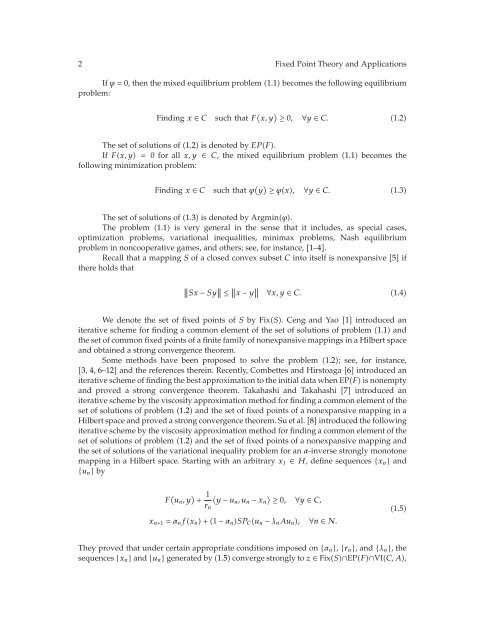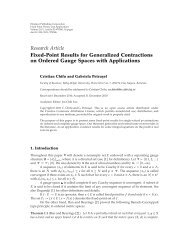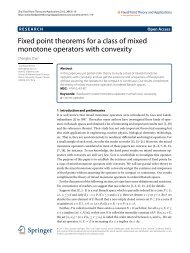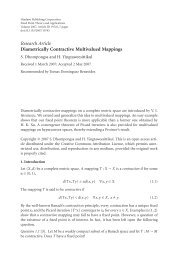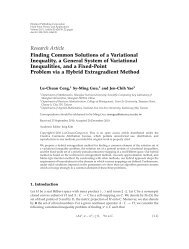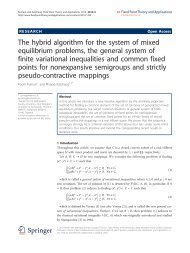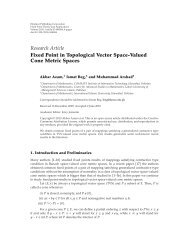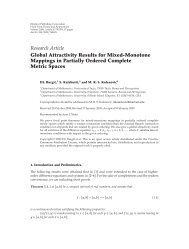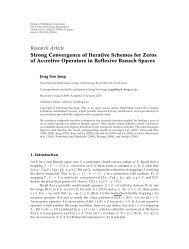PDF - Fixed Point Theory and Applications
PDF - Fixed Point Theory and Applications
PDF - Fixed Point Theory and Applications
You also want an ePaper? Increase the reach of your titles
YUMPU automatically turns print PDFs into web optimized ePapers that Google loves.
2 <strong>Fixed</strong> <strong>Point</strong> <strong>Theory</strong> <strong>and</strong> <strong>Applications</strong><br />
If ϕ 0, then the mixed equilibrium problem 1.1 becomes the following equilibrium<br />
problem:<br />
Finding x ∈ C such that F x, y ≥ 0, ∀y ∈ C. 1.2<br />
The set of solutions of 1.2 is denoted by EPF.<br />
If Fx, y 0 for all x, y ∈ C, the mixed equilibrium problem 1.1 becomes the<br />
following minimization problem:<br />
Finding x ∈ C such that ϕ y ≥ ϕx, ∀y ∈ C. 1.3<br />
The set of solutions of 1.3 is denoted by Argminϕ.<br />
The problem 1.1 is very general in the sense that it includes, as special cases,<br />
optimization problems, variational inequalities, minimax problems, Nash equilibrium<br />
problem in noncooperative games, <strong>and</strong> others; see, for instance, 1–4.<br />
Recall that a mapping S of a closed convex subset C into itself is nonexpansive 5 if<br />
there holds that<br />
<br />
Sx − Sy ≤ x − y ∀x, y ∈ C. 1.4<br />
We denote the set of fixed points of S by FixS. Ceng <strong>and</strong> Yao 1 introduced an<br />
iterative scheme for finding a common element of the set of solutions of problem 1.1 <strong>and</strong><br />
the set of common fixed points of a finite family of nonexpansive mappings in a Hilbert space<br />
<strong>and</strong> obtained a strong convergence theorem.<br />
Some methods have been proposed to solve the problem 1.2; see, for instance,<br />
3, 4, 6–12 <strong>and</strong> the references therein. Recently, Combettes <strong>and</strong> Hirstoaga 6 introduced an<br />
iterative scheme of finding the best approximation to the initial data when EPF is nonempty<br />
<strong>and</strong> proved a strong convergence theorem. Takahashi <strong>and</strong> Takahashi 7 introduced an<br />
iterative scheme by the viscosity approximation method for finding a common element of the<br />
set of solutions of problem 1.2 <strong>and</strong> the set of fixed points of a nonexpansive mapping in a<br />
Hilbert space <strong>and</strong> proved a strong convergence theorem. Su et al. 8 introduced the following<br />
iterative scheme by the viscosity approximation method for finding a common element of the<br />
set of solutions of problem 1.2 <strong>and</strong> the set of fixed points of a nonexpansive mapping <strong>and</strong><br />
the set of solutions of the variational inequality problem for an α-inverse strongly monotone<br />
mapping in a Hilbert space. Starting with an arbitrary x1 ∈ H, define sequences {xn} <strong>and</strong><br />
{un} by<br />
F un,y 1<br />
rn<br />
<br />
y − un,un − xn ≥ 0, ∀y ∈ C,<br />
xn1 αnfxn 1 − αnSPCun − λnAun, ∀n ∈ N.<br />
They proved that under certain appropriate conditions imposed on {αn}, {rn}, <strong>and</strong>{λn}, the<br />
sequences {xn} <strong>and</strong> {un} generated by 1.5 converge strongly to z ∈ FixS∩EPF∩VIC, A,<br />
1.5


